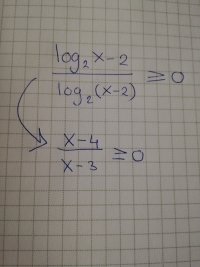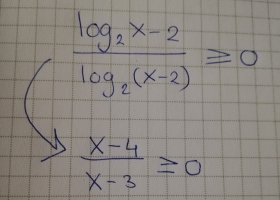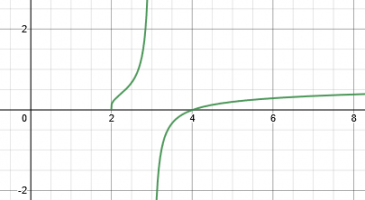Thanks. It really isn't very well explained, is it? I hope this isn't from a teacher.
I was right, I think, that the supposedly transformed line is not really used, but rather the reasoning that led to it. The first two lines here state the conditions on the domains of the two logs and on the denominator, and then the conclusion, which must be based on the inequalities used to write the rational equation, not on that equation itself.
Here is the whole answer as I might put it:
The initial inequality will be true when the numerator and denominator have the same sign, or when the numerator is zero.
Since [imath]\log_2x-2[/imath] is an increasing function that is zero when [imath]x=4[/imath], the sign of [imath]\log_2x-2[/imath] is the same as the sign of [imath]x-4[/imath].
Since [imath]\log_2(x-2)[/imath] is an increasing function that is zero when [imath]x=3[/imath], the sign of [imath]\log_2(x-2)[/imath] is the same as the sign of [imath]x-3[/imath].
Therefore either [imath]x>4[/imath] and [imath]x>3[/imath], so that [imath]x>4[/imath]; or [imath]x<4[/imath] and [imath]x<3[/imath], so that [imath]x<3[/imath].
In order for the logs to be defined, we also need [imath]x>0[/imath] and [imath]x>2[/imath].
The value will be 0 when the numerator is zero, so we can include [imath]x=4[/imath], but not [imath]x=3[/imath].
Putting these inequalities together, [imath]x\ge 4[/imath] or [imath]x<3[/imath], and [imath]x>2[/imath], resulting in the interval [imath](2,3)\cup[4,\infty)[/imath].
I never followed through to check the solution, so now I need to ask whether you copied the problem incorrectly. Did they really solve it with [imath]\le[/imath] instead of [imath]\ge[/imath]? Here is the graph:




